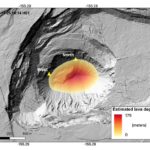Hawaiian Volcano Observatory update for Saturday, Dec. 26, 2020, at 9:14 a.m.:
HAWAIIAN VOLCANO OBSERVATORY DAILY UPDATE
U.S. Geological Survey
Saturday, December 26, 2020, 9:14 AM HST (Saturday, December 26, 2020, 19:14 UTC)
KILAUEA VOLCANO (VNUM #332010)
19°25’16” N 155°17’13” W, Summit Elevation 4091 ft (1247 m)
Current Volcano Alert Level: WATCH
Current Aviation Color Code: ORANGE
Activity Summary: Lava activity is confined to Halemaʻumaʻu from two vents on the north and northwest sides of the crater. As of 2 pm yesterday, the crater lake was still 176 m (577 ft) deep and the lake level appeared to be 2 m (6 ft) lower leaving a narrow black ledge around the north edge. Early this morning, the west vent reactivated while the north vent quieted and started to drain the lake. Reduced SO2 emissions were measured last night.
Summit Observations: Preliminary analysis of sulfur dioxide emission rates measured last night suggest that the rates have dropped to 16,000-20,000 tonnes/day [from 30,000 to 40,000 tonnes on previous days]. Summit tiltmeters continued to record slowing deflationary tilt until just before 3 am this morning (Dec. 26) when it switched to inflationary tilt. Seismicity remained elevated but stable, with a few minor earthquakes and tremor fluctuations related to the vigor of fissure fountaining.
Halemaʻumaʻu lava lake observations: The north vent continued erupting lava into a lake within Halemaʻumaʻu crater. The west vent was incandescent until about 2:40 am this morning (nearly coincident with the switch from deflationary to inflationary summit tilt) when it became vigorously active with up to 3 narrow lava streams into the lake . After 3 am the north vent quieted and started to slowly drain lava from the lake.
The lava lake within Halemaʻumaʻu crater remained about 176 m (577 ft) deep and about 415 m (1,360 ft) below the Halemaʻumaʻu rim as of yesterday afternoon (Dec. 25th). The lava lake volume remained about 21 million cubic meters (27 million cubic yards or 4.8 billion gallons). USGS field crews are currently making measurements to confirm whether the lake surface continues to drop.
An island of cooler, solidified lava floating in the lava lake, which has been drifting slowly northeastward in the lake, has apparently grounded itself near the north vent. It is still about 260 m (850 ft) in length and 115 m (375 ft) in width based on the Dec. 23rd thermal map (https://www.usgs.gov/maps/december-23-2020-k-lauea-summit-eruption-thermal-map). At about 6 am this morning (Dec. 26), the island started to slowly drift to the southeast.
Webcam views of the lava lake can be found here: https://volcanoes.usgs.gov/volcanoes/kilauea/multimedia_webcams.html.
Hazard Analysis: High levels of volcanic gas, rockfalls, explosions, and volcanic glass particles are the primary hazards of concern regarding this new activity at Kīlauea’s summit. Large amounts of volcanic gas—primarily water vapor (H2O), carbon dioxide (CO2), and sulfur dioxide (SO2)—are continuously released during eruptions of Kīlauea Volcano. As SO2 is released from the summit during this new eruption, it will react in the atmosphere with oxygen, sunlight, moisture, and other gases and particles, and within hours to days, convert to fine particles. The particles scatter sunlight and cause the visible haze that has been observed downwind of Kīlauea, known as vog (volcanic smog), during previous summit eruptions. Vog creates the potential for airborne health hazards to residents and visitors, damages agricultural crops and other plants, and affects livestock operations. Rockfalls and minor explosions, such as the ones that occurred during the 2008–2018 lava lake eruption at Kīlauea summit, may occur suddenly and without warning. This underscores the extremely hazardous nature of Kīlauea caldera rim surrounding Halemaʻumaʻu crater, an area that has been closed to the public since late 2007. Pele’s hair and other lightweight volcanic glass fragments from the lava fountains within Halemaʻumaʻu will fall downwind of the fissure vents and lava lake, dusting the ground within a few hundred meters (yards) of the vent. High winds may waft lighter particles to greater distances. Residents are urged to minimize exposure to these volcanic particles, which can cause skin and eye irritation similar to volcanic ash.
Attached graphic: Lava lake level measurements collected during a field visit of Kīlauea Volcano’s summit around 2:15 p.m. HST on December 25, 2020, were used to create a preliminary lava lake depth map. When compared to pre-eruption topographic models, it shows that the bottom of Halema’uma’u crater has been filled by almost 176 m (578 ft) of lava. Map by H. Dietterich.
